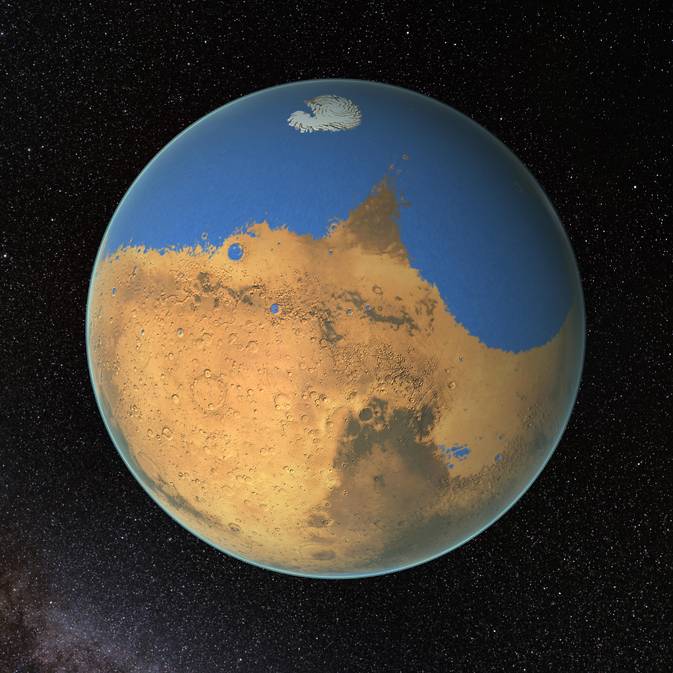Did Mars Have Flowing Water 500,000 Years Ago?

Could water have carved channels on Mars as recently as 500,000 years ago? If that's the case, it would boost the case for relatively recent life on the Red Planet.
There's abundant evidence showing that Mars was wet early in its 4.5-billion-year history, but new research suggests that the water comes in cycles, providing opportunities for life to take a hold in between the long, cold ice ages.
The suggestion comes after roughly 15 years of observations from NASA's Mars Reconnaissance Orbiter. The spacecraft's High Resolution Imaging Science Experiment (HiRISE) camera gave investigators the first high-definition look at the planet's surface. Additionally, NASA's Mars Global Surveyor spacecraft's Mars Orbiter Camera previously discovered gullies. [Photos: The Search for Water on Mars]

"What we think is, these older gullies that we’re documenting now are remnants of a time when liquid water was more feasible at these locations," said Dickson, a planetary scientist at Brown University who has examined ice on Antarctica and Mars for more than a decade.
"The atmosphere was a little thicker and there was more sunlight hitting the poles, which moved the ice from the poles to mid-latitude locations," he added.
His work was recently published in the scientific journal Icarus in a paper titled "Recent climate cycles on Mars: Stratigraphic relationships between multiple generations of gullies and the latitude dependent mantle."
Hundreds of gullies
Dickson led a recent survey of more than 200 gullies in the Red Planet's southern hemisphere, where they tend to be more abundant. A followup study targets gullies in the northern hemisphere as well, to see if the features are consistent across both halves of the planet.
Get the Space.com Newsletter
Breaking space news, the latest updates on rocket launches, skywatching events and more!
Dickson and his team discovered that the gullies did not all form at the same time. They believe that water flowed on Mars and created the gullies, with fan-shaped deposits at the mouth of the channels. Over time, meteorites and dust altered the landscape, then water flowed again and left more deposits, sometimes on top of the older ones. [7 Biggest Mysteries of Mars]
Absolute ages are difficult to estimate from orbit because measuring the half-life of radioactive elements — a common method for dating rocks exactly — is not possible from a distance. Collecting such measurements requires a rover. Scientists can estimate ages, however, based on how many craters have formed in a given area. In general, the more craters a surface has, the older it is because there would have been more time for impacts from meteorites and other small bodies.
Climate change caused by the variations in the tilt of Mars' poles may be the reason for the periodic water flows. Over time, as the pole changes tilt, sunlight hits different areas of the planet, causing the ice to migrate from the poles to more "temperate" latitudes.

Right now, Mars is in a position where liquid water is unlikely to flow at gully locations. Climate models in concert with the gully observations predict, however, that water would have flowed as recently as 500,000 years ago.
Implications for life
We don't know yet if life ever existed on the Martian surface. Water may have flowed for long periods of time, but whether the water was hospitable is an open question.
"We don’t know how acidic it was, and don’t know how much water there was," Dickson said.
What the study does point to, however, is a wider timespan for life to arise. Numerous observations of Mars in recent decades have shown evidence of not only gullies, but even a potential ancient shoreline where an ocean could have been. Furthermore, NASA's Opportunity, Spirit and Curiosity rovers have all found signs of ancient water in the rocks; Curiosity, in fact, rolled through the site of an ancient lake-and-stream system that mission scientists say could have supported microbial life, if any existed billions of years ago.

The only way to prove that water came more recently is to get a rover down into a gully. Current landing technology, however, isn't designed to do that well. The Martian atmosphere is much thinner at the high altitudes where gullies are present, making it hard to use a parachute. And there's a risk a rover could slip on the slope if controllers misdirected it.
Dickson and his collaborators suggest sending smaller spacecraft to these sites, which would be lighter under their parachutes and perhaps more nimble on the surface than the heavy Curiosity, which weighs roughly 1 ton. When that will happen, however, depends on NASA's plans after the Mars 2020 rover, a near-twin of Curiosity that so far is the last confirmed surface mission in the agency's plans.
This story was provided by Astrobiology Magazine, a web-based publication sponsored by the NASA astrobiology program. Follow Space.com @Spacedotcom, Facebook and Google+.
Join our Space Forums to keep talking space on the latest missions, night sky and more! And if you have a news tip, correction or comment, let us know at: community@space.com.

Elizabeth Howell (she/her), Ph.D., was a staff writer in the spaceflight channel between 2022 and 2024 specializing in Canadian space news. She was contributing writer for Space.com for 10 years from 2012 to 2024. Elizabeth's reporting includes multiple exclusives with the White House, leading world coverage about a lost-and-found space tomato on the International Space Station, witnessing five human spaceflight launches on two continents, flying parabolic, working inside a spacesuit, and participating in a simulated Mars mission. Her latest book, "Why Am I Taller?" (ECW Press, 2022) is co-written with astronaut Dave Williams.










